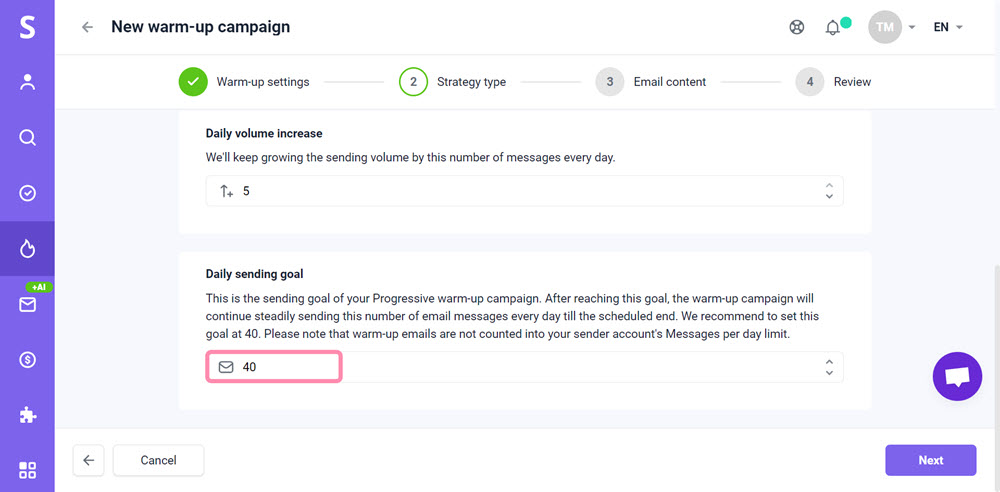This article empowers you with essential tips on how to achieve the best warm-up results and use it effectively.
Properly warmed-up email accounts provide a solid foundation for a successful cold email campaign.
The warm-up strengthens your sender reputation and improves the ability of your emails to land in the Inbox. Doing it right requires a smart approach and sticking to best practices.
Let's dig into some key things to do and to avoid for important warm-up aspects:
Warm-up period
The first recommendation is simple—don't send campaigns without the initial warm-up period.
Consider it as preparation before going live; never underestimate its importance.
The warm-up's duration depends on your email account's age and condition:
- at least 4 weeks for newly created mailboxes;
- at least 2 weeks for older accounts with some sending history.
To Do: Complete a warm-up period before sending any campaigns or cold emails. It helps your email account get in shape for real campaigns.
Keep in mind that launching an email campaign before completing the warm-up can set back its progress. Wondering why?
This is because warm-up generates only positive interactions, and real campaigns sometimes bring in the negatives (bounces, spam reports) which depletes the positive effect that was gained.
Warm-up volume (number of daily warm-up emails)
It's crucial for your email account to gradually build up its sending capacity through a proper warm-up process.
To Avoid: Don't send a large number of cold emails right away without a proper warm-up.
To Do: Build up your email account's sending capacity through the warm-up.
Decide how many emails you plan to send in real campaigns: if your plan is to send 50 emails daily in campaigns, this would be your warm-up's sending goal.
If you plan to send 200 emails daily, your warm-up goal should also be set at 200.
Keep in mind: To minimize the risks of being banned by your provider due to high sending volumes, gradually reach the sending goal by increasing your daily volume by 2-4 emails each day.
The recommended default settings for the Progressive warm-up are the following:
- Starting volume: 2
- Daily volume increase: 2
- Daily sending goal: 40
Remember: We recommend setting a daily goal of 40 emails because it is a super safe number for your account's reputation.
Still, you have the flexibility to increase it as needed based on your plan -- up to 100 emails per day is generally considered a safe sending goal.
Be cautious with significantly higher values -- anything above 100 emails per day increases the risk of receiving a temporary block from your email service provider.
Email account activity
Your sender reputation grows from a consistent email sending activity.
A period of inactivity can cause your account to lose its "warmth". When your email campaign wraps up, always start a warm-up.
To Do: Keep your account "busy" with a warm-up when you don't send any campaigns.
Set your warm-up schedule to match your usual email-sending times: this helps align with what is considered the 'usual behavior' for your email account.
This way, your email account will maintain its strength and sender reputation during periods of inactivity as you prepare for your next campaign.
Email sending volumes
One of the key settings for your campaigns is the sending limit (Messages per day). You can edit this parameter in your email account settings.
Aspect #2: Balancing cold emails and warm up emails
Considering the previous point, you may wonder how should you distribute the overall sending limit?
A good practice is to keep a 50/50 balance between cold emails and warm-up emails.
For example, 25 campaign emails and 25 warm up emails per day per email account.
Remember: Avoid sudden changes in your email sending volume (such as sending zero emails today and 100 tomorrow) — email providers may view this as suspicious activity.
On days when you either don't send any cold emails or send fewer than usual, send some warm-up emails to maintain steady activity.
Here's an example of a balanced sending activity:
Day 1: Sent 50 campaign emails — no warm-up needed.
Day 2: Sent 50 campaign emails — no warm-up needed.
Day 3: Sent 25 campaign emails — sent 25 warm-up emails to maintain balance.
Day 4: No campaign emails sent — sent 50 warm-up emails to keep the account active.
This approach keeps your email volume steady and boosts your sender reputation.
Aspect #3: Using warm-up during email campaigns
Sending cold emails often has a negative effect: bounces, spam reports from recipients, and providers blocking your emails all decrease your sender reputation.
To Do: Use warm-up emails to compensate the negative effects of sending cold emails and restore or maintain your reputation.
There may be a few scenarios on how you can add warm-up to your sending workflow:
1. You're satisfied with your campaign results:
There's no need to warm up at the same time. You can use your total daily sending limit to send campaigns.
2. Engagement rates in campaigns are good:
Hovewer, you want to ensure your Inbox rate stays high.
Throw in some warm-up emails to your total limit and increase the balance in favor of cold emails compared to warm-up emails (35 cold/15 warm-up).
3. If you observe that your open/reply rates are decreasing:
Lower the number of cold emails and increase the ratio in favor of warm-up emails (35 warm-up/15 cold or 45 warm-up/5 cold).
The warm-up process will restore your reputation through positive interactions. After a few days, you can begin to increase the volume of cold emails you send.
What’s next: using what you've learned
By applying the practical tips and strategies shared here, you can make sure the warm-up has the best positive effect and improves how well your email campaigns work.
Have questions after reading this article? Feel free to reach out to our Customer Care team at help@snov.io or via live chat.
More resources





Sorry about that 😢
How can we improve it?